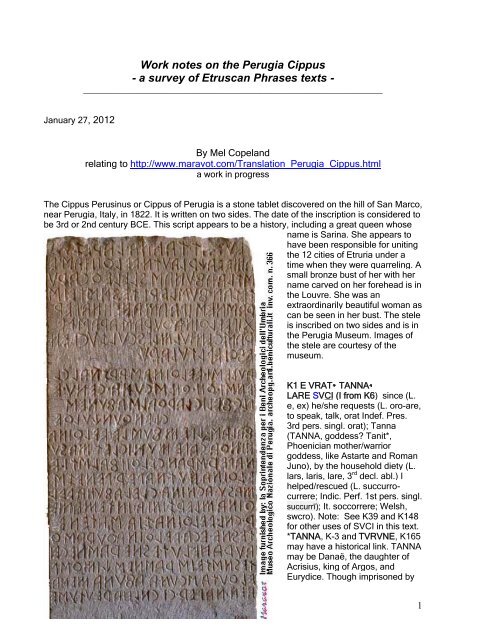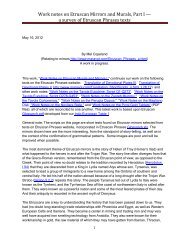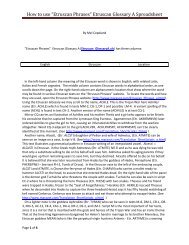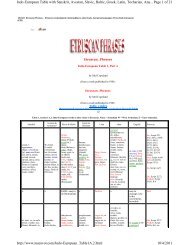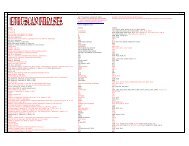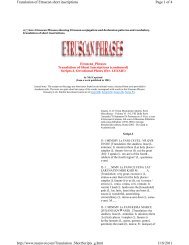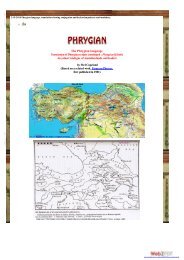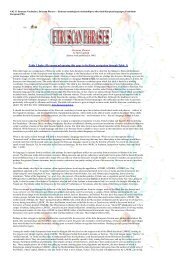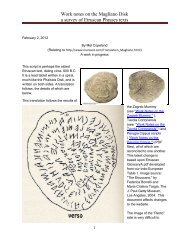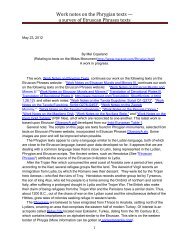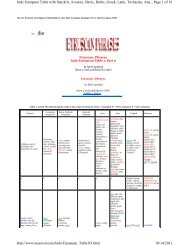Work notes on the Perugia Cippus - a survey of ... - maravot.com
Work notes on the Perugia Cippus - a survey of ... - maravot.com
Work notes on the Perugia Cippus - a survey of ... - maravot.com
You also want an ePaper? Increase the reach of your titles
YUMPU automatically turns print PDFs into web optimized ePapers that Google loves.
<str<strong>on</strong>g>Work</str<strong>on</strong>g> <str<strong>on</strong>g>notes</str<strong>on</strong>g> <strong>on</strong> <strong>the</strong> <strong>Perugia</strong> <strong>Cippus</strong><br />
- a <strong>survey</strong> <strong>of</strong> Etruscan Phrases texts -<br />
_____________________________________________________________<br />
January 27, 2012<br />
By Mel Copeland<br />
relating to http://www.<strong>maravot</strong>.<strong>com</strong>/Translati<strong>on</strong>_<strong>Perugia</strong>_<strong>Cippus</strong>.html<br />
a work in progress<br />
The <strong>Cippus</strong> Perusinus or <strong>Cippus</strong> <strong>of</strong> <strong>Perugia</strong> is a st<strong>on</strong>e tablet discovered <strong>on</strong> <strong>the</strong> hill <strong>of</strong> San Marco,<br />
near <strong>Perugia</strong>, Italy, in 1822. It is written <strong>on</strong> two sides. The date <strong>of</strong> <strong>the</strong> inscripti<strong>on</strong> is c<strong>on</strong>sidered to<br />
be 3rd or 2nd century BCE. This script appears to be a history, including a great queen whose<br />
name is Sarina. She appears to<br />
have been resp<strong>on</strong>sible for uniting<br />
<strong>the</strong> 12 cities <strong>of</strong> Etruria under a<br />
time when <strong>the</strong>y were quarreling. A<br />
small br<strong>on</strong>ze bust <strong>of</strong> her with her<br />
name carved <strong>on</strong> her forehead is in<br />
<strong>the</strong> Louvre. She was an<br />
extraordinarily beautiful woman as<br />
can be seen in her bust. The stele<br />
is inscribed <strong>on</strong> two sides and is in<br />
<strong>the</strong> <strong>Perugia</strong> Museum. Images <strong>of</strong><br />
<strong>the</strong> stele are courtesy <strong>of</strong> <strong>the</strong><br />
museum.<br />
K1 E VRAT TANNA<br />
LARE SVCI (I from K6) since (L.<br />
e, ex) he/she requests (L. oro-are,<br />
to speak, talk, orat Indef. Pres.<br />
3rd pers. singl. orat); Tanna<br />
(TANNA, goddess? Tanit*,<br />
Phoenician mo<strong>the</strong>r/warrior<br />
goddess, like Astarte and Roman<br />
Juno), by <strong>the</strong> household diety (L.<br />
lars, laris, lare, 3 rd decl. abl.) I<br />
helped/rescued (L. succurrocurrere;<br />
Indic. Perf. 1st pers. singl.<br />
succurrī); It. soccorrere; Welsh,<br />
swcro). Note: See K39 and K148<br />
for o<strong>the</strong>r uses <strong>of</strong> SVCI in this text.<br />
*TANNA, K-3 and TVRVNE, K165<br />
may have a historical link. TANNA<br />
may be Danaë, <strong>the</strong> daughter <strong>of</strong><br />
Acrisius, king <strong>of</strong> Argos, and<br />
Eurydice. Though impris<strong>on</strong>ed by<br />
1
her fa<strong>the</strong>r she bore Perseus by Zeus. Acrisius set mo<strong>the</strong>r and child adrift in a chest, but <strong>the</strong>y<br />
reached <strong>the</strong> island <strong>of</strong> Seriphus. There King Polydectes tried to force her to marry him, but<br />
Perseus eventually rescued her and took her home to Argos. According to Vergil (Aeneïd,<br />
7.371-372, 7.406-413) Danaë emigrated to Italy and founded Ardea, <strong>the</strong> capital city <strong>of</strong> her<br />
descendant Turnus, king <strong>of</strong> <strong>the</strong> Rutulians (Rutuli). The Rutuli were a tribe living in Latium. Under<br />
Turnus <strong>the</strong>y led o<strong>the</strong>r Latin tribes against Aeneas. With this in mind, seeing that this cippus<br />
c<strong>on</strong>tains a historical account, it may be that <strong>the</strong> <strong>Perugia</strong> <strong>Cippus</strong> is a c<strong>on</strong>firmati<strong>on</strong> <strong>of</strong> Virgil's myth<br />
covering <strong>the</strong> descendants <strong>of</strong> Aeneas, <strong>of</strong> <strong>the</strong> Trojan War.<br />
K-6 AME FAKeR LAVTiN FEL RINA SE she wishes? (L. amo-are) to do, produce, be <strong>of</strong><br />
service to (L. facio, facere, feci, factum; pass. fio) Lautin (Laodin?), <strong>the</strong> great (FEL) queen (L.<br />
regina-ae, f.; It. f. regina; Fr. reine, f.) herself (L. se, sese). Note: See Z656 for ano<strong>the</strong>r use <strong>of</strong><br />
FAKeR:<br />
Z656 FAKeR CEVS CILeR CFA Le SFEM CEPEN TVTIN to make, do, form, perform (L.<br />
facio, facere, feci, factum) <strong>the</strong> empty void (L. Chaos) to accelerate / hasten (L. celero-are) <strong>the</strong>re<br />
(L. ibi, illic, istic; Fr. là, y, voila; It. la, cola, vi, ci, ecco); we are accustomed (L. suemus, pl. as<br />
from sueo) <strong>the</strong>y chop / seperate (It. m. ceppo; Fr. cep, m., branches/stump/b<strong>on</strong>ds; L. separoare,<br />
to separate, to part, Ind. Pres. 3rd pers. pl. sēparant) <strong>the</strong>y guard (L. tuto-are, to protect,<br />
watch, keep; Transf. to guard against; C<strong>on</strong>j. Pres. 3rd pers. pl. tutent). Note: CEPEN is used at<br />
Z665, Z709, Z1139, Z1250, Z1359, M74.<br />
K12 STeLA A8VNAS SaLE LER CARV <strong>the</strong> stela (L. stela-ae and cippus-i; It. cippus; Gr. stele,<br />
stellein, to set up) <strong>of</strong> <strong>the</strong> Av<strong>on</strong>as (L. avunculus-I, a mo<strong>the</strong>r’s bro<strong>the</strong>r, uncle?; It. avo, ancestor),<br />
hall (It. sala, f.; Fr. salle, f.) or seat, chair (L. sella-ae) <strong>of</strong> <strong>the</strong> lord? (unable to pin down LER,<br />
LERI, LERIS) beloved (L. carus-a-um) Note: A8VNAS declines. A8VNA, K89, A8VNES, K57 ; If<br />
it declines like <strong>the</strong> name <strong>of</strong> <strong>the</strong> name <strong>of</strong> <strong>the</strong> Etruscans, RAS, RASNE, RASNA, RASNES, <strong>the</strong>n it<br />
may be ancestors (It. avo). CARV appears at ZB-4, Z842, Z1770.<br />
K18 TE SANVOS (SAN8VS) LERI TEVeNS (TE8eNS) TEIS to you (L. te) <strong>the</strong> race, family, life<br />
blood, strength, progeny? (L. sanguis-inis) or alternatively <strong>the</strong> restored? (L. sano-are; sanabo, to<br />
restore) or alternatively, I heal, restore (L. sano-are) <strong>of</strong> you (L. vos, 2nd pers<strong>on</strong> pr<strong>on</strong>. pl.) <strong>of</strong> <strong>the</strong><br />
lords (ler, leri) <strong>the</strong> divine (L. dius-a-um; adj. divinus) <strong>the</strong> gods] Note: SANVOS is probably a<br />
noun or SAN VOS. VOS appears by itself at K68. See "Etruscan Phrases" GrammarA.xls. Note:<br />
if A8VNAS refers to “ancestors” <strong>the</strong>n SANVOS “progeny” would apply.<br />
K24 RASNE SIPA AMA HENNA PER; <strong>the</strong> Etruscan (Rasne) she encloses (L. saepio, saepire,<br />
saeps, saeptum; Pres. C<strong>on</strong>j. 3 rd pers. singl. saepiat) she loves Henna (L. Henna [Enna], f. city <strong>of</strong><br />
Sicily with a temple <strong>of</strong> Ceres); through, by (L. per). Note: SIPA declines: SIP, ZB-1, SIPO, XM-8.<br />
K29 XII FEL RINA RVRAS ARAS PE (PE in line K35) twelve <strong>of</strong> <strong>the</strong> great (Fel) queen (L.<br />
regina-ae, f.; It. f. regina; Fr. reine, f.) <strong>of</strong> <strong>the</strong> countries (L. rus, ruris; 1 st decl. acc. pl. -as) altars (L.<br />
ara-ae; 1 st decl. acc. pl. -as)<br />
K35 (PE)RASCEM VLiM LE SCVL SVCI EN Perusia (<strong>Perugia</strong>, Perusia, Tuscan town; "em"<br />
suffix, 3 rd decl. singl. acc.) at times, for a l<strong>on</strong>g time now, <strong>of</strong>ten (L. olim), <strong>the</strong>re, <strong>the</strong>m (LE) <strong>the</strong><br />
school, debate (L. schola-ae) I helped (L. succurro-currere; It. soccorrere; Welsh, swcro)<br />
Behold!/Come! (L. en)<br />
K41 ES RIE PLvTV LARV you are (L. sum, esse, fui, futurus) Rhea (L. Rhea-ae) <strong>of</strong> Pluto? a<br />
spectre/mask, ghost (L. Larua, -ae) Note: If RIE is THIE - The "TH" appears to be a lower case<br />
Greek <strong>the</strong>lta (delta). The name Thieple may be Deïple, possibly named after <strong>the</strong> daughter <strong>of</strong><br />
2
Adrastus and Amphi<strong>the</strong>a who was married to Tydeus and <strong>the</strong> mo<strong>the</strong>r <strong>of</strong> Diomedes. Diomedes<br />
was an Argive leader whose fa<strong>the</strong>r, Tydeus, was killed in <strong>the</strong> expediti<strong>on</strong> remembered as "Seven<br />
against Thebes." When Diomedes reached manhood he married Aegialeia, daughter <strong>of</strong><br />
Adrastus or Aegialeus. Toge<strong>the</strong>r with <strong>the</strong> o<strong>the</strong>r s<strong>on</strong>s <strong>of</strong> <strong>the</strong> Seven, called <strong>the</strong> Epig<strong>on</strong>i, he<br />
marched against Thebes and razed it in vengeance for <strong>the</strong>ir fa<strong>the</strong>r's deaths. (End <strong>of</strong> Secti<strong>on</strong> /<br />
paragraph)<br />
K45 AVLE SI FEL RINA SARINA Le CL (CL part <strong>of</strong> K52) <strong>the</strong> prince (L. aule) and if, but if (L.<br />
si; It. se, Fr. si) <strong>the</strong> great (Fel) queen (L. f. regina; It. f. regina; Fr. f. reine) Sarina; <strong>the</strong>re (le).<br />
Note: queen Sarina’s bust is in <strong>the</strong> Louvre Museum. On her forehead is written (right to left)<br />
ANIO ANIRAM.<br />
K52 (CL)ENSI RII RILiS CVNA CENV E <strong>the</strong> Clensi (2 nd Decl. nom. pl.); kings, regents? (Fr.<br />
rois, It. rei, L. regis) I relax, weaken, release (L. relaxo-are; It. rilassare; Fr. relâcher; It. Presente,<br />
1st pers. singl. rilasso); she unites by oath (L. c<strong>on</strong>iuro-are; Present 3 rd Pers. singl. c<strong>on</strong>iūrat); to<br />
dine (L. ceno-are)] Note: <strong>the</strong> E is part <strong>of</strong> <strong>the</strong> next line; Prince Metelis, statue <strong>of</strong> an orator,<br />
menti<strong>on</strong>s <strong>the</strong> name <strong>of</strong> <strong>the</strong> Clensi (AL-6).<br />
The Orator, from Sanguineto, Italy, near Lake<br />
Trasimene, 1st. c B.C.<br />
(http://www.<strong>maravot</strong>.<strong>com</strong>/Translati<strong>on</strong>_Short_Scripts.<br />
html))<br />
AL-1 AULE (AFLE) METELIS FE FELES<br />
IR Le CLENSI <strong>the</strong> prince (L. aule) himself,<br />
Metelis you drive (L. veho, vehere, vexi, vectum) <strong>the</strong><br />
skirmishers, light-armed infantry (L. veles-itis or<br />
velites) to go (L. iri) <strong>the</strong>re (le) <strong>of</strong> <strong>the</strong> Clensi clan<br />
name)<br />
AL-8 Le ERES : TECE SANS Le V_ _ _? you err, wander (L error-are) you cover, bury (L.<br />
tego, tegere, texi, tectum) <strong>the</strong> healthy (L. sanguis-itis, m. and sanguen; It. sangue, m.; Fr. sang,<br />
m.; or healthy (L. sanus-a-um) <strong>the</strong>re (le); ...........<br />
AL-15 TVRINES KIS FLICS <strong>the</strong> people <strong>of</strong> Turin (L. Augusta Taurinorum) whom (L. quis, quid;<br />
It. chi, Fr. qui) You change, alter, bend (L. flecto, flectere, flexi, flexum; Pres. 2 nd pers. singl.<br />
flectis)<br />
K57 (E)PIC 8ELIC LAR RAL Se A8VNES <strong>the</strong> epic (L. epicus-a-um; It. epica, f.; Fr. épique,<br />
f.); <strong>the</strong> warlike (L. bellicus-a-um) godess (L. Lar, Laris, m.) Ral (Ralna? wife <strong>of</strong> <strong>the</strong> supreme god,<br />
Tini) herself (L. se, sese; It. si; Fr. se) <strong>of</strong> <strong>the</strong> Av<strong>on</strong>es] Note: "NA" and "NE" are augmentative<br />
suffixes. In script DM RALNA, <strong>the</strong> goddess and mo<strong>the</strong>r <strong>of</strong> Helen <strong>of</strong> Troy, is seated next to TINIA<br />
(Zeus / Jupiter). A8VNES declines; See A8VNAS,K12. It is possible that this is A8VNES could<br />
be <strong>the</strong> Sabines, a people north <strong>of</strong> <strong>the</strong> Latins.<br />
K63 CLENaRVN KVLeRE <strong>the</strong> Clener<strong>on</strong> she / she cultivated/worshiped (L. colo, colere, colui,<br />
cultum; coleret)] (end <strong>of</strong> secti<strong>on</strong> / paragraph) Note: CLENaRVN declines: AF-5, CLENAR:<br />
3
Script AF Pillaster, tomb <strong>of</strong> <strong>the</strong> Clautie, Caere, 4th Cent. B.C.<br />
(http://www.<strong>maravot</strong>.<strong>com</strong>/Translati<strong>on</strong>_Short_Scripts.html)<br />
AF-1 LARIS AFLE: LARIS AL CLENAR STA Le) CN SVTHI CERI KVNCE by <strong>the</strong> gods (L.<br />
Lars, Laris; 2 nd Decl. Abl. -is) <strong>the</strong> prince (L. aule); <strong>of</strong> him (It. al) by<br />
<strong>the</strong> gods (L. Lars, Laris; 2 nd Decl. Abl. -is) Clenar (pers<strong>on</strong>'s name;<br />
see CLENeRVN, K63) he stands, stati<strong>on</strong>s (L. sto, stare, Indic. Pres.<br />
3rd Pers. singl. stat) <strong>the</strong>re (Fr. la); CN (CN, abbreviati<strong>on</strong> <strong>of</strong> name,<br />
Cnaeus (L. Cn, Cnaeus-i); underneath, below (Fr. soute, f.; It. sotto.,<br />
adv. , prep. under, underneath, beneath, below; L. sudis-is, point,<br />
pile) you bewailed (L. queror, queri) <strong>the</strong> trumpet/purple cloth (L<br />
c<strong>on</strong>cha-ae, shellfish, esp. mussel, pearl, purple dye; transf. a vessel<br />
like a shell, i.e., salt-cellar or trumpet) Note: CERI is used at Z665.<br />
AF13 APA Ce ATIC SANIS FARVI CESV he goes away (L.<br />
abeo, abi-itum) or alternatively he drinks to us (water, to drink (L.<br />
beo-bere; It. bere; PIE*ap, hap, water) to us (It. ce) Attica (L. Atticaae)<br />
by healthy/sounds (pl.) (L. sanus-a-um, 2 nd Decl. Abl. pl. –is) drink<br />
made <strong>of</strong> spelt, corn? (L. ferreus-a-um,-i, Nom. M. Pl.) to rest (L.<br />
cesso-are). FARVI declines: FAR, FARSI, FARSIT.<br />
AF-20 CLAF TIE THVRASI <strong>the</strong> staff, club, purple stripe worn by senators and knights (L.<br />
clava-ae; It. clava; clavus-i, nail, spike, tiller, helm) <strong>of</strong> <strong>the</strong> day (L. dies-ei, day; diu, by day;<br />
diutiuus, l<strong>on</strong>ger; Welsh, dydd; Scot, di) <strong>the</strong> breastplate (L. thorax-acis, breastplate, cuirass).<br />
Note: This pillaster from <strong>the</strong> tomb <strong>of</strong> <strong>the</strong> Clautie in Caere c<strong>on</strong>firms <strong>the</strong> word/meaning <strong>of</strong> Suthi,<br />
also used in Script A-2 which identifies <strong>the</strong> place <strong>of</strong> Tanaquil's tomb:<br />
A-1 – ECA SVTHI (SV I) TANCHVILVS (TAN VILVS MAS NIA Le behold! (L. en! ecce!)<br />
underneath, below (Fr. soute, f.; It. sotto., adv. , prep. under, underneath, beneath, below; L.<br />
sudis-is, point, pile) Tanaquil Masnial (pers<strong>on</strong>'s name). This may be <strong>the</strong> wife <strong>of</strong> Lucius<br />
Tarquinius Priscus, <strong>the</strong> fifth king <strong>of</strong> Rome. "Tanaquil, a highborn and ambitious Etruscan<br />
woman, urged her husband to move from Tarquinia to Rome in order to advance his fortunes.<br />
Her training in <strong>the</strong> Etruscan art <strong>of</strong> augury <strong>of</strong>ten aided her husband in his affairs. At his death her<br />
str<strong>on</strong>g-mindedness and quick thinking assured <strong>the</strong> thr<strong>on</strong>e to <strong>the</strong>ir s<strong>on</strong>-in-law, Servius Tullius, in<br />
accordance with her husband's wishes. " Masnial, name, may refer to a modern form, as in <strong>the</strong><br />
name <strong>of</strong> <strong>the</strong> Neopolitan insurgent Tommaso Antiello Masaniello (1620-1647) or <strong>the</strong> name <strong>of</strong> a<br />
place. Masaniello is a popular name <strong>of</strong> Italian restaurants.<br />
K65 8ALAS KIEM 8VSLE FEL RINA <strong>the</strong> valley (L. valles-is; It. vallata, valle, f.; Fr. val, m.); I<br />
call by name, summ<strong>on</strong> (L. cieo, ciere, civi, citum; Ind. C<strong>on</strong>j. 1 st Pers. singl., cieam) Vosle<br />
(Fiesole, Faesulae); <strong>the</strong> great (fel) queen (L. f. regina; It. f. regina; Fr. f. reine)] Note: Fiesole is<br />
an old Etruscan city, a part <strong>of</strong> Florence (Firenze).<br />
K71 HINeRA CAPE MVNI CLET MASV; Hinera (Himera? Hot springs and river <strong>on</strong> <strong>the</strong> north<br />
coast <strong>of</strong> Sicily, near Panormus) she captures (L. capio, capere, cepi, captum; imperative, cape)<br />
or alternately, to <strong>the</strong> cape, end (It. capo) M<strong>on</strong>iclet, name? or alternatively, <strong>the</strong> ramparts or<br />
fortificati<strong>on</strong>s (L. moenia-ium) clet (unknown), to mass/I build (Fr. masser; L. f. massa-ae, a lump,<br />
mass; It. f. massa, mass, bunch;, maso, boulder. Note: Hiner, Hinera, Hinerv (L. hinnio-ire, to<br />
neigh, whinny) is a name in <strong>the</strong> wrappings <strong>of</strong> <strong>the</strong> Zagreb Mummy. The <strong>Perugia</strong> <strong>Cippus</strong> appears<br />
to be identifying Hinera as a queen <strong>of</strong> <strong>the</strong> valley <strong>of</strong> Fiesole/Florence, and, if this is correct, we<br />
4
have an exciting link in ano<strong>the</strong>r document, <strong>the</strong> Zagreb Mummy, whose pers<strong>on</strong> may have been<br />
Hinera. This prospect, <strong>of</strong> course, is tentative until <strong>the</strong> cippus is pro<strong>of</strong>ed. HINeRA declines:<br />
HINeR, Z1205, HINeRA, Z1628, Z1083, Z1405, Z1639, K71, HINeRV, Z1236.<br />
K75 NAPER SaRAN CSL RII 8ALSTI F truly (L. ne [nae]) throughout (L. per) or<br />
alternatively, Naper, name?; <strong>the</strong>y hoe/weed (L. sarrio [sario]-ire-ui and -ivi); or alternatively, <strong>the</strong>y<br />
make clear, make bright (L. sereno-are) .); kings, regents? (Fr. rois, It. rei, L. regis) you<br />
streng<strong>the</strong>ned/fortified with a palisade (L. vallo-are; 2nd pers. pl. imp., vallavistis) or alternatively,<br />
you were well, str<strong>on</strong>g (L. valeo, valere, valuisti); F bel<strong>on</strong>gs <strong>on</strong> <strong>the</strong> next line] Note: CSL appears<br />
to be a numeral. In Greek <strong>the</strong> sum would be: 56.<br />
K79 (F)EL RINA HVT NAPER PENEIS to <strong>the</strong> great queen (L. regina, f.; It. regina, f.; Fr.<br />
reine, f.) high, l<strong>of</strong>ty, eminent, important (Fr. haut; hausser, to raise, lift) Naper, name? <strong>of</strong> Peneis,<br />
place, River Peneus in Thessaly, Greece, also <strong>the</strong> river god, Peneius, fa<strong>the</strong>r <strong>of</strong> <strong>the</strong> nymph<br />
Daphne?<br />
K84 MASV ACNINA CLE Le A8VNA FEL I mass (Fr. masser; (L. massa-ae, f., a lump,<br />
mass; It. massa, f., mass, bunch) <strong>of</strong> <strong>the</strong> lambs (L. agna-ae f., <strong>of</strong> a lamb, agninus-a-um; 2 nd Decl.<br />
Nom. pl.) <strong>the</strong> key (L. f. clava-ae, f.; It. chiave, f.; Fr. clé, f.) <strong>the</strong>re Av<strong>on</strong>a <strong>the</strong> great (fel). Note:<br />
A8VNA declines: A8VNAS, K12, K175, A8VNES, K57.<br />
K92 RINAM LER SINIA IN TEMA ME queen (L. regina-ae, 2 nd Decl. Acc. singl. –am, f.; It.<br />
regina, f.; Fr. reine, f.) <strong>the</strong> lord? (ler) Sinia (Siena?); in (L. in) fear (It. tema, timore); (ME to line<br />
107)] Note: <strong>the</strong> suffix, "ia," <strong>of</strong> SINIA identifies it as a proper name.<br />
K97 (ME)R CN Le FEL RINA SIA SATENE I obtain/merit (L. mereo, and mereor) <strong>of</strong> Gnaeus<br />
(abbrev. Cn) <strong>the</strong>re (Fr. la, le) ; <strong>the</strong> great queen (L. f. regina; It. f. regina; Fr. f. reine) whe<strong>the</strong>r (L.<br />
sive, seu; It. sia; Welsh, ai, os; Fr. si que, soit que) Satene, name] Note: CNL could be a Greek<br />
number whose sum equals 100. SIA might indicate an Italian Past Subj. case). SIA is used at<br />
K168 and S-10:<br />
Lemnos Script (http://www.<strong>maravot</strong>.<strong>com</strong>/Lemnos_Script.html)<br />
S-1 HeRPAIE: Se: NAPH (NAø) THeCHSI ASI:<br />
Herpaie, name, 5th decl. gen., perhaps based <strong>on</strong><br />
<strong>the</strong> word for scimitar (L. harpes-es, f.),himself (L.<br />
se, sese) unfortunate (L. nefas; It. nefasto; Fr.<br />
néfast) I protected/covered (L. tego, tegere, texi,<br />
tectum, Ind. Perf. 1 st pers. singl. tēxī) <strong>the</strong> Asians<br />
(L. Asia-ae). Note: The nominative pl. –ae seems<br />
to c<strong>on</strong>sistently translate to – i in Etruscan. The<br />
"ie" suffix marks HeRPAIE as a noun. See also<br />
<strong>the</strong> word NAPHAR (S-1).<br />
S-8 MARAS: MAF <strong>the</strong> seas (L. mare-is) bad,<br />
evil (Fr. mauvais); "ie" and "ia" suffix are gen. or<br />
dat. endings.<br />
S-10 SIA PAEFEIS: AFIS whe<strong>the</strong>r (L. sive, seu;<br />
It. sia; Welsh, ai, os; Fr. si que, soit que) <strong>the</strong><br />
shields (It. pavese, f.); for eternity (L. aevum-in, n.<br />
5
a. aevus-i, 2 nd Decl. dat. pl. -is)<br />
S-15 EFISeCHeR: SERReN AIeCH SIFAI to tear in pieces / disembowel (L. eviscero-are);<br />
<strong>the</strong>y are serene (L. sereno-are, Ind. Pres. 3 rd pers. singl. serēnat; It. sereno; Fr. serein) ( Sivai?<br />
(name, Sivai; Sanscrit: Shiva, <strong>the</strong> destroyer, resp<strong>on</strong>sible for <strong>the</strong> form <strong>of</strong> change and <strong>the</strong><br />
shedding <strong>of</strong> old habits.)<br />
S-18 AKER: TA FARSITH <strong>the</strong> land (L. ager, agri) <strong>of</strong> you, yours (L. ta) he fills(L. farcio, farcire,<br />
farsi, fartum, Ind. Pres. 3 rd pers. singl. farcit)<br />
S-22 FAMA PASIA Pe: SERReN AIMeR RINA IP <strong>the</strong> talk, fame (L. fama-ae, f.) <strong>of</strong> Peace ( L.<br />
pax, pacis, 3 rd Decl. Nom. pl. n.-ia) through (L. per): <strong>the</strong>y are serene (L. sereno-are, Ind. Pres.<br />
3 rd pers. singl. serēnat; It. sereno; Fr. serein) to love <strong>the</strong> (L. amo-are) <strong>the</strong> queen/regent (L. f.<br />
regina; It. f. regina; Fr. f. reine) myself? (L. ipse-a-um)<br />
K105 TESeNE ECA FEL RINA RVRAS R (R to line K110) I design/point out (L. designo-are,<br />
Ind. C<strong>on</strong>j. 1 st Pers. singl. dēsignem, to design); behold! (or adv., "this is") <strong>the</strong> great (fel) queen<br />
(L. regina, f.; It. regina, f.; Fr. reine, f.) <strong>of</strong> <strong>the</strong> countries (L. rus, ruris; 1 st decl. acc. pl. -as). Note<br />
RVRAS declines: RVRAS, K39, RVRVS, AG-1. RVRVS –os appears to designate a name, as in<br />
EIFAS, TELMVNVS (Ajax Telem<strong>on</strong>os, hero <strong>of</strong> <strong>the</strong> Trojan War).<br />
K110 (R)A VRA HE LV TESeNE RASNE CEI <strong>the</strong> defendant/party in a lawsuit (L. rea-ae, f.<br />
reus-i, m.) she speaks, talks (L. oro-are, Ind. Pres. 3 rd pers. singl. orat; Palaic, wer) you<br />
have/hold (L. habeo-ere) it (It. lo) I design/point out (L. designo-are, Ind. C<strong>on</strong>j. 1 st Pers. singl.<br />
dēsignem, to design) <strong>the</strong> Etruscan (Rasne) any, some (L. quae)<br />
K117 TESeNS TEIS RASNES KIMeRS P designs (L. designo-are, to design; It. disegno,<br />
design) by <strong>the</strong> gods (L. deus, divus; di [dii], divi, 2 nd Decl. Dat./Abl. pl. -is) <strong>of</strong> <strong>the</strong> Etruscans<br />
(Rasnes) <strong>the</strong> chimaera-ae, f, 1 st Decl. Abl. pl -is - see <strong>the</strong> Chimaera <strong>of</strong> Arezzo) (P to K123) Note:<br />
TESeNS TEIS RASNES all agree in number and case, suggesting that TESENS is a noun pl.<br />
K123 (P)EL RVTAS CVNA A8VNA MENA <strong>the</strong> skin (L. pellis-is; It. pelle; Fr. peau; peler, to<br />
skin) you whirl around (L. roto-are; rotas, you rotate) she c<strong>on</strong>spires/takes an oath (L. c<strong>on</strong>iuroare)<br />
<strong>of</strong> Av<strong>on</strong>a, name she leads (It. menare; Fr. mener)] Note: See SPEL at K152.<br />
K129 HE Se NAPER CI CN Le HAREV TVSE you have (L. habeo-are) itself, herself (L. se,<br />
sese; It. si; Fr. se) Naper, name; who, which (L. qui, quae, quod; It. chi; Fr. qui) CN (L. Cn,<br />
Cnaeus-i, abbreviati<strong>on</strong> <strong>of</strong> name, Cnaeus) <strong>the</strong>re (le) or alternatively this is a number, Greek, 100,<br />
CNL; to draw out, empty (L. haurio, haurire) <strong>the</strong> leader, ruler (L. dux, ducis, 1 st Decl. Abl. pl. -a)<br />
(End <strong>of</strong> side 1)<br />
(Side 2)<br />
K146 FEL RINA S (S to line K148)<br />
<strong>the</strong> great (fel) queen (L. regina, f.; It. regina, f.; Fr. reine, f.)<br />
K148 SATENA SVCI (I from line K150) Satena I helped (help, to succor (L. succurro-currere;<br />
It. soccorrere; Welsh, swcro) or alternatively, associated, allied, an ally (L. socia-ae, socius-aum).<br />
Note: SATENA declines: SATENE, K103.<br />
K150 E NESCI IP (IP to line K152); alternatively TF (E may be part <strong>of</strong> SVCI, K148) from (L. e,<br />
6
ex) <strong>the</strong> ignorant? (L. nescio-ire, not to know, to be<br />
ignorant; nescius-a-um, , 2 nd Decl. Nom. –i, not<br />
knowing, ignorant, unaware) or she did not know]<br />
See also K171 E NESCI.<br />
K152 (IP)A or TFA SPE LANE <strong>the</strong> two (L. duoae-o;<br />
It. due; Fr. deux; Welsh, dau, dwy; Gr. Dyo;<br />
Persian, do) you hope? (L. sperare; spes-ei, hope;<br />
It. sperare; Fr. ésperer) <strong>of</strong> wool? (L. lana-ae)<br />
K154 RI VOLVM (8VLVM) matters (L. res, ri) <strong>of</strong><br />
<strong>the</strong> volume (L. volumen-inis, a scroll, book, wreath,<br />
fold; It. volume; Fr. volume, bulk, mass, volume)<br />
K156 CHUAS (KFAS) FELaRI <strong>the</strong> end, dam,<br />
close (It. chiusa, f.) or alternatively, <strong>the</strong> choice,<br />
excellent (Fr. choix, choisi) Felari. (gens. pl.) Note:<br />
See FELaR, FELaRA, FELaRE.<br />
K159 RENERI EST she had reigned (L.Passive,<br />
C<strong>on</strong>d. Perf. 3 rd pers. singl., regnā́ tus est)<br />
K161 AC FEL RINA indeed, and also (L. ac) <strong>the</strong><br />
great (Fel) queen (L. regina, f.; It. regina, f.; Fr.<br />
reine, f.)<br />
K164 ACILVNE nor<strong>the</strong>rn (L. aquil<strong>on</strong>ius-a-um,<br />
2nd Decl. Gen. singl. -i), i.e., "<strong>the</strong> great nor<strong>the</strong>rn<br />
queen." The next word at K165 appears to be <strong>the</strong><br />
city <strong>of</strong> Turin, and this would be <strong>the</strong> nor<strong>the</strong>rn-most<br />
city; possibly “indeed, <strong>the</strong> great nor<strong>the</strong>rn queen <strong>of</strong><br />
Turin.”<br />
K165 TVRVNE (SC to line 168) Tur<strong>on</strong>e (Turin?<br />
L. taurinus-a-um, <strong>of</strong> or like a bull; Taurinorum,<br />
Turin)<br />
K168 SCVNE SIA LVCI (I from line 171) people,<br />
<strong>the</strong> Sc<strong>on</strong>e? i.e., Tusc<strong>on</strong>e? whe<strong>the</strong>r (L. sive, seu; It.<br />
sia; Welsh, ai, os; Fr. si que, soit que) <strong>of</strong> <strong>the</strong><br />
Lucans (L. 1 st Decl. pl. –ae) or alternatively <strong>of</strong> <strong>the</strong><br />
locati<strong>on</strong>s (L. locus-i, place, regi<strong>on</strong>)] Note: Because<br />
<strong>of</strong> <strong>the</strong> punctuati<strong>on</strong> mark after TVRVNE <strong>the</strong> SC goes with K168. Likewise <strong>the</strong> punctuati<strong>on</strong> mark is<br />
after <strong>the</strong> I in LVCI.<br />
K171 E NESCI A R (R to line K173) from, out <strong>of</strong> (L. e, ex) not knowing, unaware (nescius-aum,<br />
2 nd Decl. Nom. –i), not knowing, ignorant, unaware) to, at (L. a) See also K151 E NESCI.<br />
K173 (R)VMI CaSa AVONAS (A8VNAS) <strong>the</strong> Romans (L. Roma-ae, 1 st Decl. Nom. pl. –ae); It.<br />
Romano; Fr. Romain) house (L. casa-ae); Av<strong>on</strong>as, name; NAS from line K176.<br />
7
K176 (NAS) PENaRIA (A from K178) <strong>of</strong> or for <strong>the</strong> provisi<strong>on</strong>s? (L. penarius-a-um, 2 nd Decl.<br />
Nom. pl. -a), or a bread-basket (L. panarium-i, , 2 nd Decl. Nom. pl. –a) or alternatively, a place,<br />
Penaria? The “ia” suffix suggests a pers<strong>on</strong> or place name.<br />
K178 (A) AMA FEL R (R to line K181) to (L. a) she loves (L. amo-are, Act. Pres. 3 rd pers.<br />
singl. amat) <strong>the</strong> great (fel)<br />
K181 (R)INA AVO (A8V) II queen (L. regina-ae; It. regina; Fr. reine); <strong>the</strong> grandfa<strong>the</strong>r, ancestor<br />
(L. avus-i) II<br />
K183 RVR VNI E III<br />
from, out <strong>of</strong> III<br />
I drop dew, moisten, bedew, anoint (L. roro-are) <strong>the</strong> goddess Uni; by,<br />
K186 SEQIVII AC L (L to line 188) differently from (sequius, secus, o<strong>the</strong>rwise, not so; foll., by<br />
atque, ac, or quam, o<strong>the</strong>rwise than, differently from (L. ac, atque)<br />
K188 (L)ARI Le ROI PE <strong>the</strong> gods (L. lar, laris) <strong>the</strong>re (le, la) <strong>the</strong> king, regent (L. rex, regis; It.<br />
re; Fr. roi) by (L. per)<br />
K191 VLeR LICH (LIK) CA <strong>the</strong> swan (L. olor-oris) or Oler, pers<strong>on</strong>’s name, I bind (L. ligo-are)<br />
or alternatively, Olerlich, name, by which way, as far as (L. qua)<br />
K194 CECHASI (CEKASI) CHOLE (KVLE) anything (It. checchessia, anything, everything,<br />
chicchessia, any<strong>on</strong>e, anybody; Fr. quelquechose) he/she will inhabit, cultivate (L. colo, colere,<br />
Indic. Fut. 3 rd pers. singl. colet)<br />
(End <strong>of</strong> <strong>Perugia</strong> <strong>Cippus</strong> Text)<br />
Launched: 01.24.12<br />
Updated: 1.27.12<br />
Copyright © 1981-2012 Mel Copeland. All rights reserved.<br />
8


